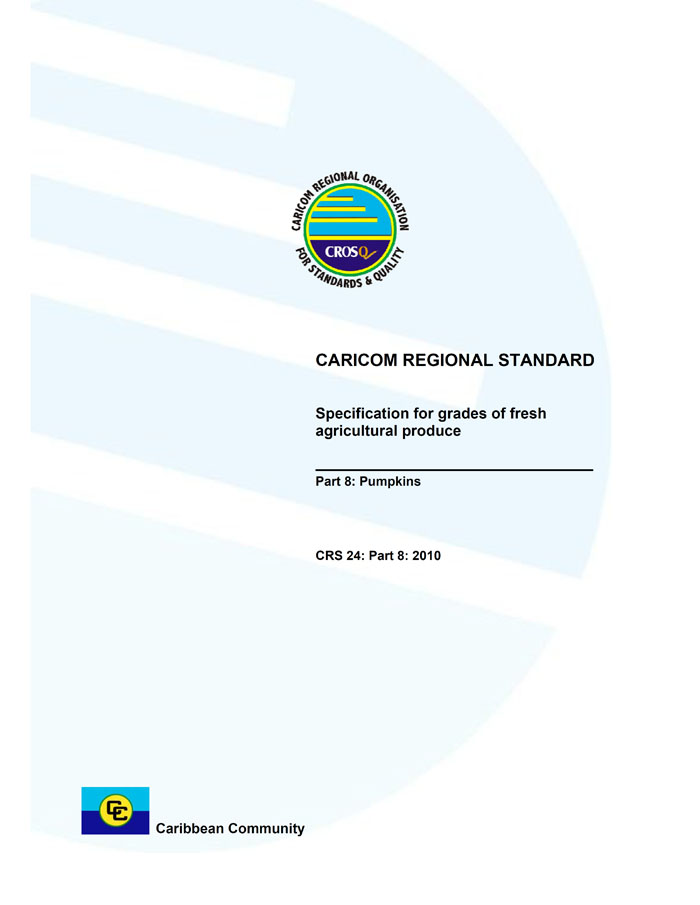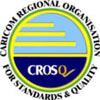
In order to promote public education and public safety, equal justice for all, a better informed citizenry, the rule of law, world trade and world peace, this legal document is hereby made available on a noncommercial basis, as it is the right of all humans to know and speak the laws that govern them.


CARICOM Regional Organisation for Standards and Quality (CROSQ)
2nd Floor Nicholas House
29 & 30 Broad Street
Bridgetown, St Michael
Barbados
T: 246.622.7670 | F: 246.622.7678
Website: http://www.crosq.org
© CROSQ 2010 – All rights reserved
Unless otherwise specified, no part of this publication may be reproduced or utilized in any form or by any means, electronic or mechanical, including photocopying and microfilm, without permission.
CRS 24: Part 8: 2010
CARICOM Regional Organisation for Standards and Quality (CROSQ)
2nd Floor, Nicholas House
29 & 30 Broad Street
Bridgetwon, St. Michael
Barbados
T: 246.622.7670 | F: 246.622.7678
Website: http://www.crosq.org
© CROSQ 2010 – All rights reserved. No part of this publication is to be reproduced without the prior written consent of CROSQ.
ISBN 978-976-8234-10-0
ICS 67.080
| AMENDMENT NO. | DATE OF ISSUE | TYPE OF AMENDMENT | NO. OF TEXT AFFECTED | TEXT OF AMENDMENT |
|---|---|---|---|---|
This CARICOM Regional Standard was prepared under the supervision of the Regional Technical Committee for Agricultural Commodities (RTC 19), (hosted by the CARICOM Member State, Dominica), which at the time comprised the following members:
| Members | Representing |
|---|---|
| Mr. Lloyd Pascal (Chairperson) | Dominica Export Import Agency (DEXIA) |
| Mr. Ricky Allport | Division of Agriculture, Dominica |
| Mr. Ryan Anselm | Plant protection and Quarantine Services, Dominica |
| Mr. Kent Coipel | Inter-American Institute for Cooperation on Agriculture (IICA) |
| Mr. Clement Ferreira | Nature’s Best, Dominica |
| Mrs. Marcella Harris | Windward Islands Farmers Association (WINFA) |
| Mr. Cecil Joseph | Dominica Hucksters Association (1995) Ltd. (DHA) |
| Mr. Rawle Leslie | Dominica State College – Agriculture Faculty |
| Mr. Angus Mclntyre | Windward Island Banana Development Cooperation (WIBDECO) |
| Gregory Robin, PhD | Caribbean Research and Development Institute (CARDI) |
| Mr. John Robin | Agro-processors Association of Dominica (APAD) |
| Mr. Delroy Williams | National Association of Youth in Agriculture (NAYA), Dominica |
| Dr. Nadia Pacquette-Anselm (Technical Secretary) | Dominica Bureau of Standards |
| Foreword | 1 | |||
| 1 | Scope | 2 | ||
| 2 | Terms and definitions | 2 | ||
| 3 | Requirements | 3 | ||
| 3.1 | Quality | 3 | ||
| 3.1.1 | Minimum requirements | 3 | ||
| 3.1.2 | Classifications and tolerances | 4 | ||
| 3.2 | Sizing | 5 | ||
| 4 | Packaging | 5 | ||
| 5 | Labelling | 5 | ||
| 5.1 | Container labelling | 5 | ||
| 6 | Contaminants | 5 | ||
| 6.1 | Heavy metals | 5 | ||
| 6.2 | Pesticides residues | 6 | ||
| 7 | Hygiene and sanitatiion | 6 | ||
| List of tables | ||||
| Table 1 — Size determination of pumpkin | 5 | |||
This CARICOM Regional Standard was developed in an effort to:
This standard was approved by the Twenty-ninth Council for Trade and Economic Development (COTED) on 8-9 February 2010.
In the development of this standard, assistance was derived from the following:
NOTE During the development of this standard, the CARICOM Regional Code of Practice for Food Hygiene was still under development.
1This standard specifies the quality requirements for pumpkin, Cucurbita pepo (Duch. Ex Lam.) to be supplied fresh to the consumer at the preparation and packaging stages.
This standard does not apply to products for industrial processing.
The following referenced documents are indispensable for the application of this document. For dated references, only the edition cited applies. For undated references, the latest edition of the referenced document (including any amendments) applies.
CODEX Alimentarius Commission, Principles for the Establishment and Application of Microbiological Criteria for Foods (CAC/GL 27- 1997)
For the purposes of this standard, the following terms and definitions shall apply.
any physical injury affecting the surface of the pumpkin, such as scars, scratches or sunscald, which detracts from its natural appearance, but will not significantly affect its shelf life
free from loose or adhering soil, chemical deposits and all foreign matter and odour
80 % of the pumpkin exhibits a colour typical of the variety at maturity
the weight placed in the package takes account of the expected natural weight loss and ensures that the buyer gets the net weight/count stated on the package
defect, injury or any combination of these such as bruises, cuts, soft spots, growth cracks or scars caused by pests, physical or physiological disorder, which detract from the cosmetic appearance, edible and marketing qualities
absence of insects on, or in, the pumpkin, or in the package, at any stage of development
not soft, spongy or noticeably wilted and skin not swollen
free from any visible evidence of moulds, fungal and bacterial rots, spots or any symptoms of viral infection
2two or more pumpkins whether or not packaged, but sold as one distinct and separate group
stage of development where optimum growth characteristics of the variety are attained, and post harvest handling is not adversely affected. This usually occurs when the tendril nearest the fruit has begun to wilt or dry, the skin gloss is lost and the fruit sounds hollow when tapped with the back of the finger
stem is intact and trimmed to a length of not greater than 1.25 cm (0.5 inches)
packed in clean containers
skin and flesh colour, texture, shape and size typical of the variety
normal shape for the cultivar, but not flat-sided or in any way abnormal in shape
90 % of the fruit exhibits a colour that is typical of the variety at maturity
Pumpkins shall meet or exceed the following minimum requirements subject to the special provisions specified in 4.1.2:
Pumpkins shall be classified as Class I, Class II or Class III. Each class shall be allowed a degree of tolerance as specified below to account for human error in sorting and packing, and for the deterioration in quality that may occur between the point of dispatch and receipt. The degree of tolerance allowed should not be deliberately exploited by the packer.
Pumpkins shall meet the minimum requirements in 4.1.1 and, in addition, shall meet the following requirements:
Pumpkins shall meet the minimum requirements in 4.1.1 and, in addition, shall meet the following requirements:
Pumpkins shall conform to the minimum requirements in 4.1.1 and, in addition, shall meet the following requirements:
Size shall be determined by the maximum and minimum weight of the individual pumpkin in kg as outlined in Table 1.
| Size code | Maximum weight kg | Minimum weight kg |
|---|---|---|
| Small | 5 | <5 |
| Medium | 10 | 5 |
| Large | 15 | 10 |
| Extra large | 25 | 15 |
| Giant | >25 | 25 |
Pumpkins shall be packaged in material free from soil, dirt or foreign matter adhering to or inside the container. The contents of each package shall be uniform and consist of the same variety, quality, size and class.
Each container of pumpkins shall bear the following particulars, visibly, legibly and indelibly marked in the official language(s) of the country in which the produce is to be sold:
NOTE 1 Instructions on general handling of containers is optional.
NOTE 2 The use of red or orange should be avoided since these colours are used in the labelling of dangerous goods.
Pumpkins shall comply with those maximum levels for heavy metals established by the CODEX Alimentarius Commission for this commodity.
5Pumpkins shall comply with the maximum residue limits established by the CODEX Alimentarius Commission for this commodity.
It is recommended that the produce covered by the provisions of this standard be prepared and handled in conjunction with the appropriate clauses of the latest edition of the CARICOM Regional Code of Practice for Food Hygiene or other international Codes of Practice which are relevant to this commodity.
In keeping with good manufacturing practice, pumpkins shall be free from objectionable matter.
Pumpkin shall comply with any microbiological criteria established in accordance with the Principles for the Establishment and Application of Microbiological Criteria for Foods (CAC/GL 27- 1997).
Pumpkins shall comply with Sanitary and Phyto-Sanitary (SPS) requirements of the importing and exporting countries.
6
The CARICOM Regional Organisation for Standards and Quality (CROSQ) was created as an Inter-Governmental Organisation by the signing of an agreement among fourteen Member States of the Caribbean Community (CARICOM). CROSQ is the regional centre for promoting efficiency and competitive production in goods and services, through the process of standardization and the verification of quality. It is the successor to the Caribbean Common Market Standards Council (CCMSC), and supports the CARICOM mandate in the expansion of intra-regional and extra-regional trade in goods and services.
CROSQ is mandated to represent the interest of the region in international and hemispheric standards work, to promote the harmonization of metrology systems and standards, and to increase the pace of development of regional standards for the sustainable production of goods and services in the CARICOM Single Market and Economy (CSME), and the enhancement of social and economic development.
CROSQ VISION:
The premier CARICOM organisation for the development and promotion of an Internationally Recognised Regional Quality Infrastructure; and for international and regional harmonized CARICOM Metrology, Standards, Inspection, Testing and Quality Infrastructure
CROSQ MISSION:
The promotion and development of standards and standards related activities to facilitate international competitiveness and the sustainable production of goods and services within the CARICOM Single Market and Economy (CSME) for the enhancement of social and economic development
7 8